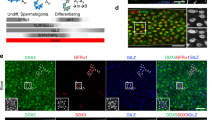Summary
Spermatogenesis is an orderly process whereby male germ cells pass through sequential phases of differentiation to develop into mature spermatozoa. At present, little is known about the factors that regulate this process. The POU domain represents a group of transcription-activator proteins with well-described roles in development. These proteins have been shown to regulate the tissue-specific expression of genes involved in cellular differentiation. The recent identification of Sperm-1, a testis-specific POU-domain protein expressed in primary spermatocytes just prior to the onset of meiosis, suggests that this protein may be involved in the regulation of male germ-cell differentiation. Continued evaluation of Sperm-1 and other related transcriptional activators may shed some light on the regulation of spermatogenesis.
Similar content being viewed by others
References
Andersen B, Pearse RV, Schlegel PN, Cichon Z, Schonemann MD, Bardin CW, Rosenfeld MG (1993) Sperm 1: a POU-domain gene transiently expressed immediately before meiosis I in the male germ cell. Proc Natl Acad Sci USA 90:11084–11088
Andersen B, Schonemann MD, Flynn FE, Pearse RV II, Singh H, Rosenfeld MG (1993) Skn-la and Skn-li: two functionally distinct Oct-2-related factors expressed in epidermis. Science 260:78–82
Andersen B, Schonemann MD, Pearse RV, Jenne K, Sugarman J, Rosenfeld MG (1993) Brn-5 is a divergent POU domain factor highly expressed in layer IV of the neocortex. J Biol Chem 268:23390–23398
Clermont Y, Perry B (1957) Quantitative study of the cell population of the seminiferous tubules in immature rats. Am J Anat 100:241–260
Clermont Y, Trott M (1969) Duration of the cycle of the seminiferous epithelium in the mouse and hamster determined by means of 3H-thymidine and autoradiography. Fertil Steril 20:805–817
Gerhing WJ (1987) Homeoboxes in the study of development. Science 236:1245–1252
Goldsborough AS, Healy LE, Copeland NG, Gilbert DJ, Jenkins NA, Willison KR, Ashworth A (1993) Cloning, chromosomal localization and expression pattern of the POU domain gene Oct-11. Nucleic Acid Res 21:127–134
Herr W, Cleary MA (1995) The POU domain: versatility in transcriptional regulation by a flexible two-in-one DNA-binding domain. Genes Dev 9:1679–1693
Herr W, Sturm RA, Clerc RG, Corcoran LM, Baltimore D, Sharp PA, Ingraham HA, Rosenfeld MG, Finney M, Ruvkun G, Horvitz HR (1988) The POU domain: a large conserved region in the mammalian pit-1, oct-1, oct-2 and Caenorhabiditis elegans unc-86 gene products. Genes Dev 2:1513–1516
Kapiloff MS, Farkash Y, Wegner M, Rosenfeld MG (1991) Variable effects of phosphorylation of Pit-1 dictated by the DNA response elements. Science 253:786–789
Klemm JD, Pabo CO (1996) Oct-1 POU domain-DNA interactions: cooperative binding of isolated subdomains and effects of covalent linkage. Genes Dev 10:27–36
Okamoto K, Wakamiya M, Noji S, Koyama E, Taniguchi S, Takemura R, Copeland NG, Gilbert DJ, Jenkins NA, Muramatsu M, Hamada H (1993) A novel class of murine POU gene predominantly expressed in central nervous system. J Biol Chem 268:7449–7457
Ruvkun G, Finney M (1991) Regulation of transcription and cell identity by POU domain proteins. Cell 64:475–478
Schonemann MD, Ryan AK, McEvilly RJ, O'Connell SM, Arias CA, Kall KA, Li P, Sawchenko PE, Rosenfeld MG (1995) Development and survival of the endocrine hypothalamus and posterior pituitary gland requires the neuronal POU domain factor Brn-2. Genes Dev 9:3122–3135
Scott MP, Tamkun JW, Hartzell GW (1989) The structure and function of the homeodomain. Biochim Biophys Acta 989:25–48
Segil N, Roberts SB, Heintz N (1991) Mitotic phosphorylation of the Oct-1 homeodomain and regulation of Oct-1 DNA binding activity. Science 254:1814–1816
Simmons DM, Voss JW, Ingraham HA, Holloway JM, Broide RS, Rosenfeld MG, Swanson LW (1990) Pituitary cell phenotypes involve cell-specific Pit-1 mRNA translation and synergistic interactions with other classes of transcription factors. Genes Dev 4:695–711
Stoykova AS, Sterrer S, Erselius JR, Hatzopoulos AK, Gruss P (1992) Mini-Oct and Oct-2c: two novel, functionally diverse murine Oct-2 gene products are differentially expressed in the CNS. Neuron 8:541–558
Verrijer CP, Vliet PC van der (1993) POU domain transcription factors. Biochim Biophys Acta 1173:1–21
Xia Y-R, Anderson B, Mehrabian M, Diep AT, Warden CH, Mohandas T, McEvilly RJ, Rosenfeld MG, Lusis AJ (1993) Chromosomal organization of mammalian POU domain factors. Genomics 18:126–130
Author information
Authors and Affiliations
Rights and permissions
About this article
Cite this article
Zini, A., Mielnik, A. & Schlegel, P.N. POU-domain gene expression during spermatogenesis. World J Urol 14, 274–277 (1996). https://doi.org/10.1007/BF00184599
Issue Date:
DOI: https://doi.org/10.1007/BF00184599




